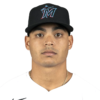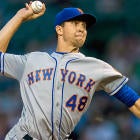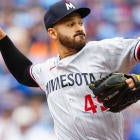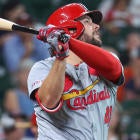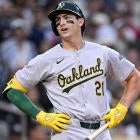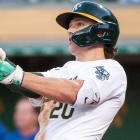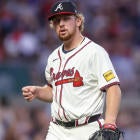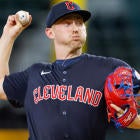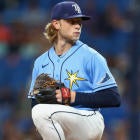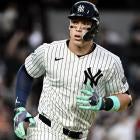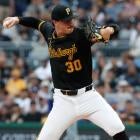Want to get a jump on the competition? Go to the CBS Sports app on your phone, open up "Settings" and sign up for Fantasy alerts to get the latest from our Fantasy baseball team as soon as it's available.
For each of the categories in this series I've shown you what it takes to compete for first place and what a middle-of-the-pack finish looks like. I'm not sure any of them were as surprising to me as the ERA numbers.
In 2018, the average first place team in ERA sat at 3.51 while seventh place was more than half a run higher at 4.04. I expected the difference to be much smaller. While the difference of a half of a run in ERA for one pitcher isn't a huge amount of variance, it's significant when you're talking about a full Fantasy roster.
What makes it slightly frustrating is that we also know pitchers don't control quite as much of their ERA as we thought, but that doesn't mean it's a lost cause. There are multiple strategies you can take to manage the category.
One of the strategies I prefer is one I mentioned in the WHIP article; stacking your team with elite relievers and streaming your way into contention in wins and strikeouts. But innings minimums and the depth of your league could make that difficult.
Another is to dedicate a lot of resources to aces early in the draft, but that makes it difficult to compete in the hitting categories while also getting quality closers. I think a better approach is a combination of the two.
There are 18 starting pitchers in my rankings I feel confident are going to help you in ERA (and other areas) in 2019. Make it a priority to land two of them, likely in the first 4-5 rounds. Then sit out starting pitchers for a while. Aim to land three closers you feel are very solid in their role (two is OK if you come up short). Late in the draft, and through the reserve rounds, focus on high-upside starting pitchers (you'll see two below) as well as two elite middle relievers.
In theory this should give you a great start on ERA with your elite starters and closers. Your last 2-3 pitching spots will be filled by middle relievers early as you see which upside starters are going to find success in the majors this season. If you fall behind on wins and/or strikeouts, you'll always have the streaming option to fall back on.
2018 Leaders
- Jacob deGrom - 1.70
- Blake Snell - 1.89
- Trevor Bauer - 2.21
- Aaron Nola - 2.37
- Justin Verlander - 2.52
- Max Scherzer - 2.53
- Miles Mikolas - 2.83
- Kyle Freeland - 2.85
- Mike Foltynewicz - 2.88
- Gerrit Cole - 2.89
What you need to win
Below you'll find the average ERA by place for the category in 2018. These numbers are for a standard mixed, 12-team league. In an eight- or 10 team league, these numbers would be higher. In a 15-team league you could aim lower.
| Place | ERA |
| 1st | 3.51 |
| 3rd | 3.75 |
| 5th | 3.90 |
| 7th | 4.04 |
| 9th | 4.18 |
| 11th | 4.37 |
Sleeper
Jesus Luzardo may not be on the Athletics' opening day roster, but it wouldn't be a surprise to see him in Oakland by the end of April. He's worth drafting and holding until then because the sky is the limit.
Across three levels in 2018, Luzardo posted 10.6 K/9 while walking just 30 batters in 109.1 innings. Limiting contact and throwing strikes is a great combination that is only buoyed by the fact he's allowed just nine home runs in his minor-league career. Luzardo will pitch half of his games in Oakland's pitcher-friendly atmosphere, and should face the rebuilding Mariners and Rangers multiple times.
He's not just a ERA sleeper, this is the type of late-round pick you could look back on in October as a category (and league) winner.
Breakout
Those numbers from last year look really impressive, don't they? Well, it was just 23 innings. Let's look at what James did in the minor leagues. In 114.1 innings at Double-A and Triple-A, James had a 3.23 ERA with 13.5 K/9. Yeah.
There's still the minor issue of earning a spot in the starting rotation, but unless the Astros make a free agent move in the next month, that shouldn't be a problem. Even if they do, James may be able to pitch his way in with a good spring.
I'm not sure he has the upside of Luzardo, but James could be a big-time strikeout pitcher who helps your ERA and wins a bunch of games on one of the best teams in baseball. This is the type of breakout candidate you want at the back of your rotation.
Bust
Mike Foltynewicz is the third Brave in my bust section so far, but it's nothing against Atlanta. The Braves have more than a rotation full of starting pitchers who could be great for them this year, and I just don't believe Foltynewicz is one of them. His peripherals (3.77 xFIP, 3.77 SIERA) quickly tell a story of a pitcher who was very fortunate to be on the ERA leaderboard in 2018. What's more, I'm not sure he's even as good as they suggest.
For one thing, he saw a spike in his K/9 last year (9.93) despite the fact his swinging strike rate (10.3 percent) was only slightly better than his career rate (9.7 percent). He's one of the most likely regression candidates in baseball this season in a variety of ways. I wouldn't want him as anything more than my fifth starter.
AL-Only Target
If anyone was taking Keller's 2018 seriously, I might call him a bust too. But as an AL-only pick, he offers a decent option even if only as a home streamer. Keller is an elite ground ball pitcher (54 percent) who should have a good defense behind him. He'll pitch half of his games in a big park and the AL Central figures to be one of the weaker offensive divisions in baseball. Keller won't strike anyone out and his win total will be subpar, but I would anticipate an above-average ERA in AL-Only.
NL-Only Target
Derek Holland has a lot in common with Keller because he had a much better 2018 than his 2019 consensus ranking would suggest. He'll pitch his home games in a pitcher-friendly park, but his wins will be held back by the roster around him. Unlike Keller, Holland actually missed some bats with a 10.1 percent swinging strike rate that was his highest since 2014. Holland isn't a sure thing in 2019, but he profiles as someone who should at least be considered in mixed leagues and would be must-start in NL-only.


